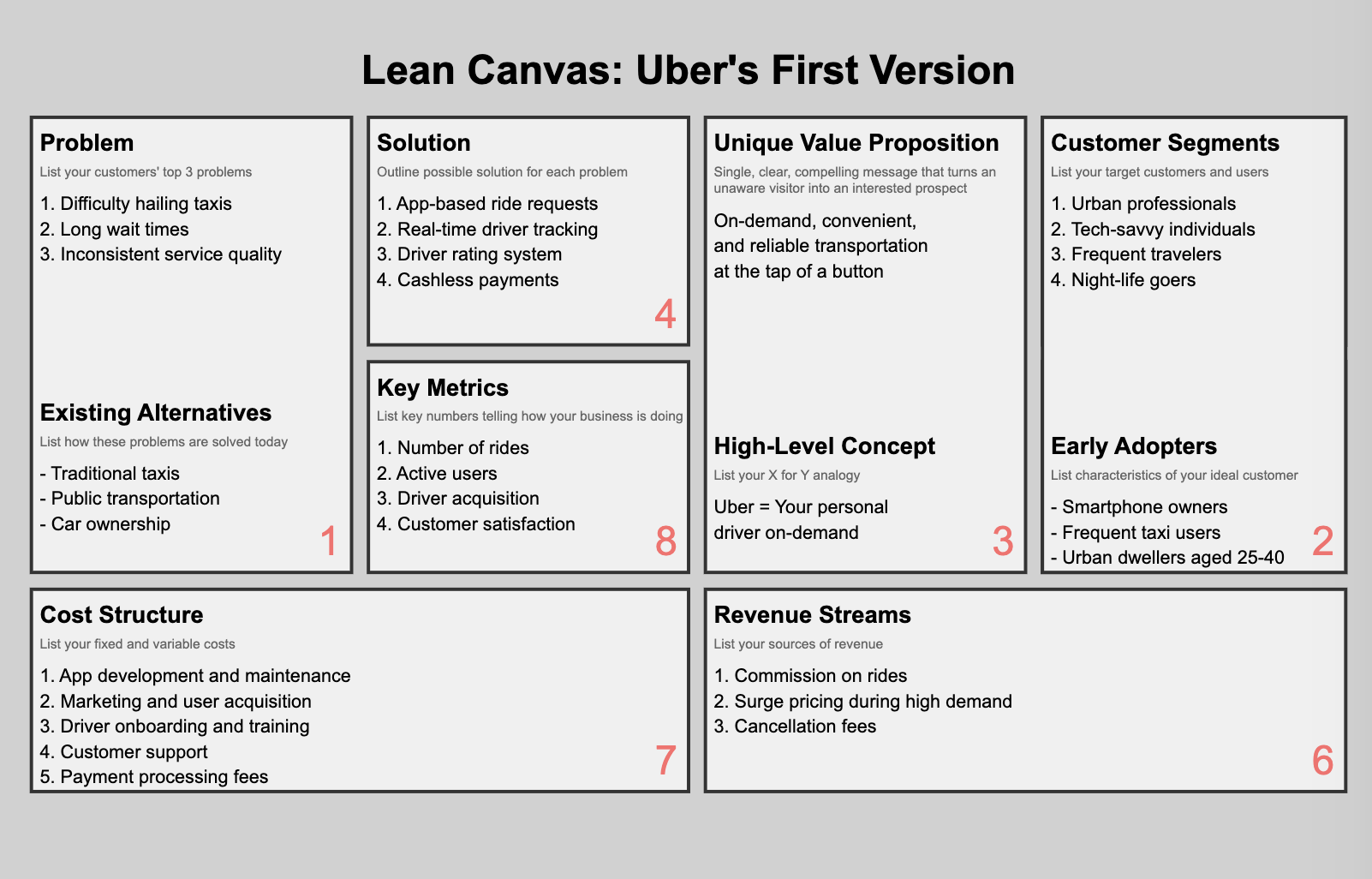Lean Canvas - A One-Page Business Model
Nobody likes spending weeks crafting a 50-page business plan that'll gather dust on a shelf. Enter the Lean Canvas – your one-page business plan on steroids. A Lean Canvas allows entrepreneurs and teams to think systematically about their business idea and address crucial questions without getting lost in the weeds. Remember, sometimes less is more. By boiling down your business concept to its essence, you're forced to focus on what really matters.
A good Lean Canvas should contain your value proposition, customer segments, revenue streams, and other key elements. It's the "source of truth" for founders, investors, and team members to quickly grasp the core of your business idea. This tool will increase understanding, alignment, and maybe even spark some "aha!" moments across your team. It's also a natural place where people can collaborate, challenge assumptions, and refine the business model.
Lean Canvases and thinking about your business in a structured way will prove very useful for pitching to investors, onboarding new team members, and keeping everyone focused on what's important.
What makes a good Lean Canvas
A good Lean Canvas should describe your business idea concisely, highlight the problems you're solving, and demonstrate a clear path to creating value and generating revenue. We believe that this document must contain the following sections:
- Problem - What pain points are you addressing?
- Customer Segments- Who are your target customers?
- Unique Value Proposition - Why should customers choose you?
- Solution - How will you solve the problem?
- Channels - How will you reach your customers?
- Revenue Streams- How will you make money?
- Cost Structure- What are your main expenses?
- Key Metrics - How will you measure success?
- Unfair Advantage- What sets you apart from the competition?
To keep the canvas concise, it's best to use bullet points and short phrases rather than long paragraphs. There's a solid chance that you'll be tempted to cram too much information into your canvas, so we believe these principles should be applied when creating Lean Canvases:
- Keep it simple and concise - if you can't fit it on one page, you're doing it wrong
- Use clear, jargon-free language- your grandma should be able to understand it
- Update continuously - a static canvas is a useless canvas
- Co-create it with your team - two heads (or more) are better than one
Examples
Here is an example of a potential Lean Canvas that could have been used for the first version of Uber.
We have included numbering to show you the approximate sequence how you should fill a Lean Canvas.
How to get started
You can use this template to get started, and follow the steps below:
- Set aside dedicated time: Schedule 2-3 hours of uninterrupted time to focus on crafting your initial Lean Canvas draft.
- Start with the Problem (1): Clearly articulate the top three problems your product aims to solve. This will guide the rest of your canvas.
- Define your Customer Segments (2): Describe your ideal users or customer segments in detail.
- Craft your Unique Value Proposition (3): Distill your offering into a clear, compelling statement that sets you apart.
- Outline your Solution (4): Briefly describe how you'll address each problem for your customers.
- Define your Unfair Advantage (5): What do you have that others can't easily copy or buy?
- Add Revenue Streams (6): Outline how you'll make money and your major revenue sources.
- Map out your Cost Structure (7): List your fixed and variable costs.
- Identify Key Metrics (8): Determine the main numbers you'll track to measure your success.
- Establish your Channels (9): List how you'll reach and acquire customers.
- Review and refine: Read through your draft, ensuring it's concise, clear, and covers all essential points. Aim for a single-page document.
- Share with your team: Distribute the draft Lean Canvas to key team members for feedback and collaborative input.
- Iterate and update: Based on feedback and new insights, revise and refine your Lean Canvas. Remember, it's a living document that should evolve with your business.
- Set up a review schedule: Plan regular intervals (e.g., monthly or quarterly) to revisit and update your Lean Canvas as your business grows and pivots.
Remember, the goal is to create a clear, concise snapshot of your business that aligns your team and guides your strategy. Don't aim for perfection in the first draft; it's more important to get your thoughts down and start the collaborative process.
FAQ
Isn't the Lean Canvas just oversimplifying things?
Sure, you could write a novel about your business idea, but who's going to read it? The Lean Canvas forces you to distill your concept to its essence. It's not about dumbing things down; it's about clarity and focus. You can always expand on the details later.
Why do I need a Lean Canvas if I already have a detailed business plan?
Think of your Lean Canvas as the highlight reel of your business plan. It's perfect for quickly communicating your idea to investors, new team members, or when you need a refresher on your core business model. Plus, it's a lot easier to update a one-page canvas than a 50-page document when things inevitably change (and they will).
